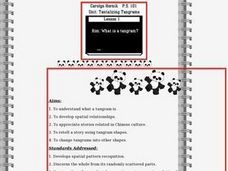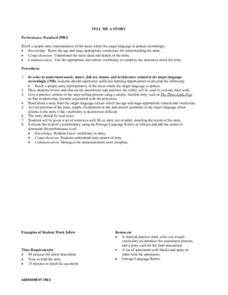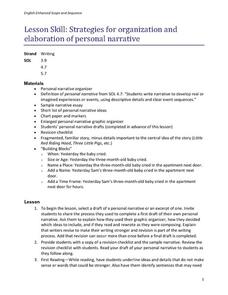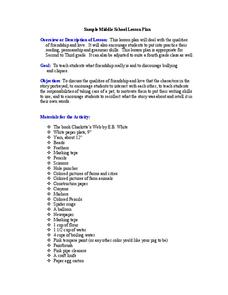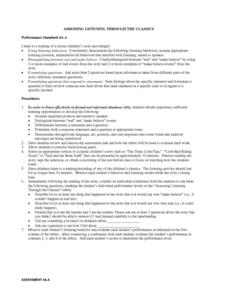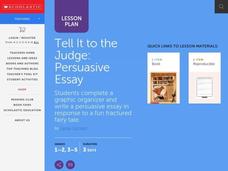Curated OER
Fabulous Fairy Tales
Young scholars examine how story telling using literary elements found in fairy tale genre is one way to read and retell, discuss and analyze, as well as write and produce their own fairy tales.
Florida Center for Reading Research
Fluency: Connected Text, Express It!
Partners practice reading fluency by reciting sentence strips to each other with proper expression and intonation. Partner A chooses a strip at random and reads it silently, then aloud with expression. Partner B reads the same sentence...
Curated OER
Do You Know What You Just Read?
Students answer reading comprehension questions using the "story grammar" technique. They listen to a story and then answer questions using the technique: main character, setting, main events, and resolution. Students complete an...
Curated OER
What is a Tangram?
Students identify a tangram. In this geometry activity, students read Grandfather Tang's Story and retell each story using the tangrams on a flannel board. Students use tangrams to complete an included worksheet.
Pennsylvania Department of Education
Comparing Two Versions of The Mitten
Students listen to two versions of the story The Mitten and create a chart or a Venn Diagram to compare the two versions. In this literary comparison instructional activity, students create a chart or Venn Diagram and discuss the...
Curated OER
Tell Me A Foreign Language Story
Students practice retelling a simple story representative of the country where the target language is spoken: French, German, or Spanish. Given a worksheet with story details, students fill in missing details and rearrange details to...
Curated OER
Strategies for Organization and Elaboration of Personal Narrative
Personal narrative writing is usually a favorite form of writing for youngsters because they get to write about a personal experience. The lesson here asks pupils to take a piece of narrative writing and improve it by following...
Curated OER
Fractured Fairy Tale Worksheet
Explore fairy tales using this worksheet. Learners read parts of traditional fairy tales and then write their own versions. They complete five fairy tales in this manner. What a motivating way to cover this concept.
Curated OER
Expressing Thoughts & Feelings
Students discuss an ordinary apple. They pass the apple around the room, whacking it on the floor at their turn. Students watch as the teacher cuts open the apple showing them it looks the same on the outside, but is bruised on the...
Curated OER
Loving to Read While Learning to Express!
Students practice recognizing words more accurately, rapidly and automatically by assessing five major techniques and strategies: reading faster, reading with expression, reading smoother, reading silently, and reading voluntarily. They...
Curated OER
Fairy Tales
Students listen as the teacher reads fairy tales to students and identify patterns. They listen as the teacher re-reads the fairy tales and signal or recite patterns as they listen. Students identify patterns in the fairy tales. They...
Curated OER
Slimy Advertising and a Wicked Resume
Students compare and contrast a classic fairy tale with a fractured one. They write an advertisement that would entice a witch and a resume for a frog prince who is hiring. They publish their completed work.
Curated OER
Felt Story Adventure
Students create a story and use a felt story board to build the story.
Curated OER
Fairy Tale Facts
Students analyze fairy tale characters and story elements. In this fairy tale lesson, students label two charts for the characters and settings of a fairy tale. Students view props in story boxes and answer questions about the story...
Quia
Charlotte’s Web Lesson Plan
Make your classroom into a place of kindness and compassion with E.B White's Charlotte's Web. The first four pages of the lesson plan guide you through several steps and projects, including discussions on Charlotte and Wilbur's...
Curated OER
Personification Stories
Students create a clay object in which they are to personify. They use their own personal experiences to help the viewer imagine what it would be like to be that particular object. They also watch videos of fables to help them with...
Curated OER
ASSESSING LISTENING THROUGH THE CLASSICS
Students demonstrate listening behaviors. They assume appropriate listening position, minimize/avoid behaviors that interfere with listening, and attend to speaker. They distinguish between real and make believe and cite 2 or more...
Curated OER
Comparative and Superlative Adjectives
In this comparative and superlative adjectives worksheet, students observe pictures and write comparatives using "than" and superlatives using "the" in complete sentences. Students write answers to twenty-two sentences.
Curated OER
Transforming Fairy Tales
Learners use technology to write original fairy tales. In this fairy tale lesson, students write their version of famous fairy tales using Alphasmart or computers. Learners illustrate their stories.
Curated OER
A Togolese Tale: The Big Fire
Young scholars read a Tonolese folktale and outline the elements of the story. In groups, they discuss the various morals presented in the story and if they are unique to the Tonolese culture. To end the lesson, they identify the...
Curated OER
Persuasion
Students read various stories and write reflections in their journals. Using the text, they identify the techniques the characters used in persuading the reader or other characters in the story.They rewrite a fairy tale from the villains...
Curated OER
Tell It to the Judge - Persuasive Essay
Students compare and contrast a classic fairy tale with a fractured one and complete a graphic organizer. Then they write a persuasive essay following the steps of the writing process. Finally, students publish their completed essay and...
Curated OER
Animal Adjectives
In this reading and writing worksheet, students read 3 stories about farm animals that have acted intelligently or even heroically. Students think of 2 adjectives that describe the animal in the story and write them on the lines.
Curated OER
P is for P-P-Pumpkin
Students examine the letter 'p'. Through instruction and modeling they explore the sound the letter makes, how to make the sound with their mouths, how the letter is written, etc. They say tongue twisters with the /p/ sound in them. They...





